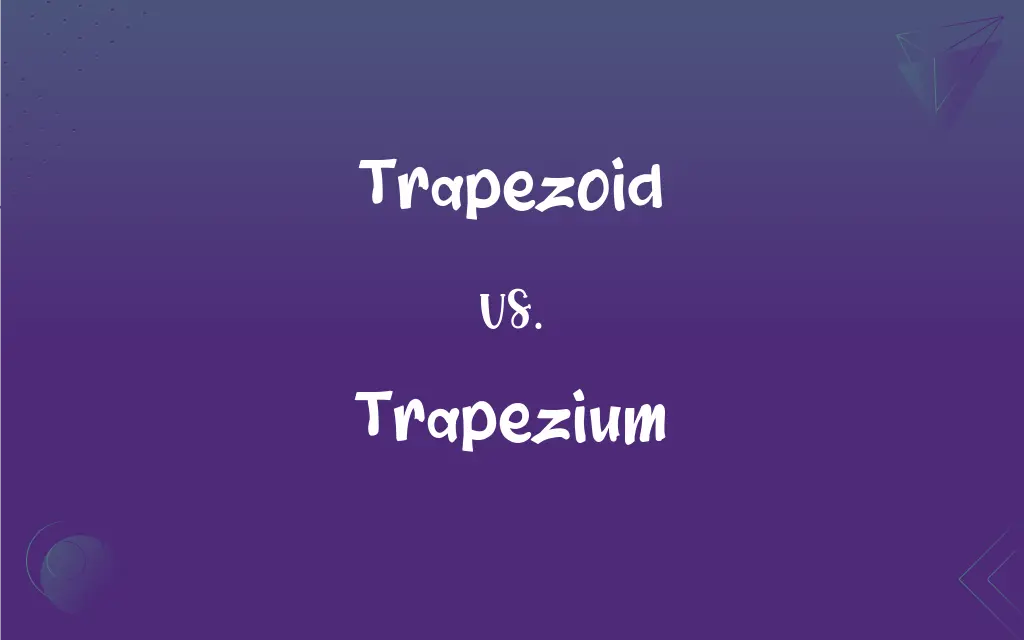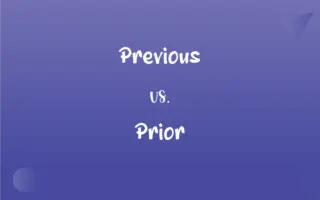Trapezoid vs. Trapezium: What's the Difference?
By Aimie Carlson & Harlon Moss || Updated on March 4, 2024
Trapezoid has at least one pair of parallel sides, whereas trapezium has no parallel sides in British English; in American English, the definitions are reversed.

Key Differences
In American English, a trapezoid is defined as a four-sided figure with at least one pair of parallel sides. This definition helps in identifying and classifying shapes based on their side properties, especially in geometry and architectural design. Conversely, in British English, the term "trapezium" is used to describe a four-sided figure with no parallel sides, showcasing the differences in terminology between the two English-speaking regions.
The classification of quadrilaterals as either trapezoids or trapeziums based on the presence or absence of parallel sides is crucial in geometry for understanding their properties and solving related problems. While American English focuses on the inclusivity of parallel sides for a trapezoid, British English emphasizes the absence of such for a trapezium. This distinction affects the way mathematical concepts are taught and understood in different parts of the world.
Educationally, the distinction between a trapezoid and a trapezium can influence the teaching curriculum and textbooks. In the United States, students learn to recognize trapezoids by identifying parallel sides, which aids in their understanding of shape properties and categorization. In contrast, British students are taught to identify trapeziums as quadrilaterals without parallel sides, affecting their approach to geometry.
Despite the terminological differences, both trapezoids and trapeziums play significant roles in various applications, from architectural design to engineering. Understanding the characteristics of these shapes helps in calculating areas, designing structures, and solving complex geometrical problems, regardless of the terminology used.
Comparison Chart
Definition
A quadrilateral with at least one pair of parallel sides
A quadrilateral with no parallel sides
ADVERTISEMENT
Parallel Sides
At least one pair
None
British Equivalent
Trapezium
Trapezoid
American Equivalent
Trapezoid
Trapezium
Use in Geometry
Shape classification and area calculation
Shape classification and area calculation
Trapezoid and Trapezium Definitions
Trapezoid
A polygon used in geometry.
She drew a trapezoid to demonstrate properties of quadrilaterals.
ADVERTISEMENT
Trapezium
A four-sided figure without parallel sides.
In British English, a trapezium has no parallel sides.
Trapezoid
A shape in architectural design.
The architect incorporated a trapezoid window for aesthetic appeal.
Trapezium
A quadrilateral in geometry.
The trapezium is an interesting shape due to its lack of parallel sides.
Trapezoid
A four-sided figure with one pair of parallel sides.
The trapezoid's parallel sides make it easy to calculate its area.
Trapezium
A shape in mathematical problems.
The problem involved calculating the perimeter of a trapezium.
Trapezoid
A figure in engineering.
The trapezoid beam distributes weight efficiently.
Trapezium
A figure in design.
The garden's trapezium layout added complexity to the design.
Trapezoid
A quadrilateral with specific properties.
A trapezoid is distinguished by having at least one pair of parallel sides.
Trapezium
A quadrilateral having no parallel sides.
Trapezoid
A quadrilateral having two parallel sides.
Trapezium
Chiefly British A trapezoid.
Trapezoid
Chiefly British A trapezium.
Trapezium
(Anatomy)A bone in the wrist at the base of the thumb.
Trapezoid
(Anatomy) A small bone in the wrist, situated near the base of the index finger.
Trapezium
A quadrilateral with two sides parallel.
Trapezoid
(Sports) An area in the shape of a trapezoid marked behind the goal line and the goal in ice hockey, where the goalie is allowed to play the puck.
Trapezium
(restrictively) A quadrilateral with two sides parallel and two sides non-parallel.
Trapezoid
A (convex) quadrilateral with two (non-adjacent) parallel sides.
Trapezium
A four-sided polygon with no parallel sides and no sides equal; a simple convex irregular quadrilateral.
Trapezoid
A convex quadrilateral with no sides parallel.
Trapezium
(anatomy) The trapezium bone of the wrist.
Trapezoid
(anatomy) The trapezoid bone of the wrist.
Trapezium
A region on the ventral side of the brain, either just back of the pons Varolii, or, as in man, covered by the posterior extension of its transverse fibers.
Trapezoid
A plane four-sided figure, having two sides parallel to each other.
Trapezium
A plane figure bounded by four right lines, of which no two are parallel.
Trapezoid
A bone of the carpus at the base of the second metacarpal, or index finger.
Trapezium
A bone of the carpus at the base of the first metacarpal, or thumb.
Trapezoid
Having the form of a trapezoid; trapezoidal; as, the trapezoid ligament which connects the coracoid process and the clavicle.
Trapezium
A quadrilateral with no parallel sides
Trapezoid
Of or pertaining to the trapezoid ligament; as, the trapezoid line.
Trapezium
A multiple star in the constellation of Orion
Trapezoid
A quadrilateral with two parallel sides
Trapezium
The wrist bone on the thumb side of the hand that articulates with the 1st and 2nd metacarpals
Trapezoid
The wrist bone between the trapezium and the capitate bones
Trapezium
A polygon with unique properties.
The trapezium was used to challenge the students' understanding of quadrilaterals.
FAQs
What defines a trapezoid in American English?
A quadrilateral with at least one pair of parallel sides.
Why is it important to know the difference between a trapezoid and a trapezium?
Understanding the difference is crucial for accurate communication in mathematics across different English-speaking countries.
Can a trapezoid have more than one pair of parallel sides?
In American English, a trapezoid must have at least one pair of parallel sides, but having two pairs would make it a parallelogram.
Are the terms trapezoid and trapezium interchangeable?
No, their definitions depend on the regional variation of English used.
Is there a shape that both British and American English agree on?
Yes, shapes like squares and rectangles have consistent definitions across both variants of English.
How do mathematicians distinguish between different types of trapezoids?
Mathematicians classify trapezoids into isosceles and right-angled types, based on the lengths of sides and angles.
Why do the definitions of trapezoid and trapezium differ between American and British English?
The difference stems from historical variations in mathematical terminology and educational standards between the two regions.
How does British English define a trapezium?
As a quadrilateral without any parallel sides.
Can a trapezium have right angles?
Yes, a trapezium can have right angles, as its definition focuses on the absence of parallel sides (in UK English) or the presence of at least one pair of parallel sides (in US English).
How does the absence of parallel sides in a trapezium affect its properties?
Without parallel sides, a trapezium does not have the geometric regularity of shapes like trapezoids, affecting properties such as symmetry and area calculation.
What is the significance of parallel sides in a trapezoid's geometry?
Parallel sides in a trapezoid determine its ability to have a consistent cross-section, which is crucial for calculations like area and volume.
What educational implications does the difference between trapezoid and trapezium have?
It affects how geometry is taught and understood in different countries, requiring educators to clarify terminology based on the English variant used.
How do architects and engineers use trapezoids or trapeziums in their work?
These shapes are used in design and structural planning, where their properties are applied to achieve aesthetic appeal and structural integrity.
What geometric properties are unique to a trapezoid?
A trapezoid uniquely features at least one pair of parallel sides, affecting its symmetry and area calculation methods.
Can trapezoids and trapeziums be found in everyday objects?
Yes, these shapes are common in architecture, design, and nature, offering both aesthetic and functional benefits.
What challenges do students face when learning about trapezoids and trapeziums?
Students may struggle with the regional differences in terminology and the concepts of parallelism and symmetry in these shapes.
What tools can be used to draw or model trapezoids and trapeziums accurately?
Tools such as rulers, protractors, and computer-aided design (CAD) software help in accurately drawing and modeling these quadrilaterals.
How do trapezoids contribute to understanding more complex geometric shapes?
Studying trapezoids helps in grasping the properties of quadrilaterals and the principles of Euclidean geometry, forming a foundation for more advanced study.
In what ways do trapezoids and trapeziums differ in their applications in physics and engineering?
These shapes are used differently based on their structural properties; trapezoids often aid in load distribution in engineering, while trapeziums can provide unique design solutions in physics simulations and engineering problems.
About Author
Written by
Aimie CarlsonAimie Carlson, holding a master's degree in English literature, is a fervent English language enthusiast. She lends her writing talents to Difference Wiki, a prominent website that specializes in comparisons, offering readers insightful analyses that both captivate and inform.
Co-written by
Harlon MossHarlon is a seasoned quality moderator and accomplished content writer for Difference Wiki. An alumnus of the prestigious University of California, he earned his degree in Computer Science. Leveraging his academic background, Harlon brings a meticulous and informed perspective to his work, ensuring content accuracy and excellence.































































